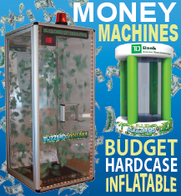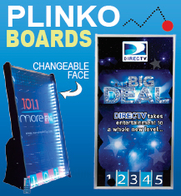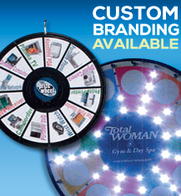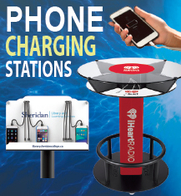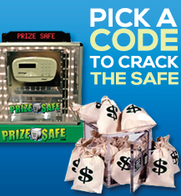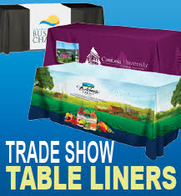 The most important element of any trade show display booth is the graphics. Your company’s logo, positioning statement, and memorable imagery should be incorporated into any well-designed exhibit. Large format printing is the procedure by which your image files are transformed into the enormous graphics that will be the focal point of your booth. Given the huge scale of standard trade show display graphics, it is obvious that large format printing requires expensive machinery and well-trained professionals.There are two types of large format printing that dominate the trade show landscape. Thermally laminated inkjet graphics and dye sublimated fabric graphics make up the vast majority of trade show graphics on the market today. Both of these processes have seen massive improvements over the past five years resulting in longer lasting graphics, increased print quality, and faster turnaround times.
The most important element of any trade show display booth is the graphics. Your company’s logo, positioning statement, and memorable imagery should be incorporated into any well-designed exhibit. Large format printing is the procedure by which your image files are transformed into the enormous graphics that will be the focal point of your booth. Given the huge scale of standard trade show display graphics, it is obvious that large format printing requires expensive machinery and well-trained professionals.There are two types of large format printing that dominate the trade show landscape. Thermally laminated inkjet graphics and dye sublimated fabric graphics make up the vast majority of trade show graphics on the market today. Both of these processes have seen massive improvements over the past five years resulting in longer lasting graphics, increased print quality, and faster turnaround times.
Thermally-Laminated Inkjet Graphics
Most pop up displays and detachable graphics use thermally laminated inkjet panels. Inkjet print heads use tiny nozzles that are thinner than a human hair to squirt ink onto the paper in tiny dots. Printers with smaller, more precise nozzles are able to print at a much higher DPI (dots-per-inch) rating, which means that the graphics will be clearer when printed. Many inkjet printers are capable of printing at well over 1200 DPI, although the human eye cannot detect the difference between 500 and 600 DPI.
Inkjet graphics are often less expensive than dye sublimated fabric graphics, but this has less to do with print quality and more to do with the cost of the machinery needed to produce trade show graphic panels. Large format and grand format inkjet printers are very cheap, easy to use, and capable of producing high quality graphics, which explains why there are thousands of small-scale printing operations in the United States alone. This is generally a benefit to consumers because it increases competition, but it is also a drawback because it allows unqualified printers to enter the market with low quality raw materials, inexperienced technicians, and outdated printers. Because the quality of inkjet graphics can vary greatly from company to company, it can be hard to tell if you are purchasing a quality product or if the company is cutting corners to save a few bucks.
For most trade show applications, inkjet graphics need to be finished with a thermal laminate to ensure the highest quality output. Many printing companies use pressure sensitive laminates for their popup displays, which is a low cost, low quality alternative. Thermal laminates are typically scratch-resistant, and they make your prints more rigid and durable. If the print is for a popup display, your panels will need to be finished with hangers, kickers, and magnetic strips so that the graphics can hang from the frame of your exhibit.
Dye Sublimated Fabric Graphics
 Dye sublimation is a graphics production process by which your image is essentially burned into a durable, washable fabric. Your image is printed first on a coated transfer paper as a mirror image of your final graphic, and is then moved onto the fabric using a heat press with rollers that operate at very high temperatures. As it passes through the rollers, the ink is heated until it “sublimates” (changes from a solid state to a gaseous state without passing through the liquid state). The gas then becomes embedded into the fabric and solidifies, which changes the color of the fabric permanently.
Dye sublimation is a graphics production process by which your image is essentially burned into a durable, washable fabric. Your image is printed first on a coated transfer paper as a mirror image of your final graphic, and is then moved onto the fabric using a heat press with rollers that operate at very high temperatures. As it passes through the rollers, the ink is heated until it “sublimates” (changes from a solid state to a gaseous state without passing through the liquid state). The gas then becomes embedded into the fabric and solidifies, which changes the color of the fabric permanently.
Dye sublimation printers can produce much higher quality graphics than inkjet printers for a few reasons. First, the inks used in the dye sublimation process are capable of changing colors by changing the temperature of the heating elements in the print heads. Inkjet printers simply place dots on the paper, and they use a process called dithering to make the dots appear to be a solid color. Secondly, inkjet ink is completely opaque, while the ink used in dye sublimation is transparent. Dye sublimation inks can be laid on top of one another to provide true solid color gradients, while inkjet inks cannot be laid on top of one another.
Large format printing is an ever-changing process with many variables. It can be hard to figure out exactly how the graphic will look without examining a sample of the graphic in person, but finding a reputable printing company will ensure that your graphics arrive on time and in good condition.
About the Author:
Andy Keeler is the President of MODdisplays, a company that specializes in the sale of portable trade show displays and exhibiting accessories. MODdisplays proudly features the Exhibit One display, the best selling hybrid exhibit on the market.










